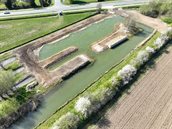Climate buffers to combat drought in West Maas en Waal
In the municipality of West Maas en Waal, climate buffers are being constructed to prevent water shortages during dry and hot periods of time. These climate buffers are located in the more elevated sections of the area. In periods of drought, the groundwater and rainwater that is stored will be added to the water system.
Nature and agriculture under pressure because of drought
The municipality of West Maas en Waal is situated in the lowest part of the Land van Maas en Waal region. In very wet periods, draining excess water is important in order to prevent waterlogging. Conversely, in periods of drought, water supply is insufficient. Especially in the western part of the municipality, the floodplains, which are nature-rich, and where farming takes place, are under pressure. The extremely dry periods of 2018 and 2022 resulted in an additional feeling of urgency in terms of ensuring the availability of a large supply of water in dry and hot times.
Five climate buffers created
Climate buffers need to provide such a supply of water. Together with the Waterschap Rivierenland regional water authorities, the municipality is creating water and climate buffers at a total of five locations, situated around the villages of Dreumel, Beneden-Leeuwen and Wamel. These buffers will provide temporary storage capacity for a total of 52 million litres of freshwater. Currently, 3.5 hectares of climate buffers are being created. At a later date, these will be supplemented with another 5 to 10 hectares of buffers.

Nature and agriculture under pressure because of drought
The municipality of West Maas en Waal is situated in the lowest part of the Land van Maas en Waal region. In very wet periods, draining excess water is important in order to prevent waterlogging. Conversely, in periods of drought, water supply is insufficient. Especially in the western part of the municipality, the floodplains, which are nature-rich, and where farming takes place, are under pressure. The extremely dry periods of 2018 and 2022 resulted in an additional feeling of urgency in terms of ensuring the availability of a large supply of water in dry and hot times.
Five climate buffers created
Climate buffers need to provide such a supply of water. Together with the Waterschap Rivierenland regional water authorities, the municipality is creating water and climate buffers at a total of five locations, situated around the villages of Dreumel, Beneden-Leeuwen and Wamel. These buffers will provide temporary storage capacity for a total of 52 million litres of freshwater. Currently, 3.5 hectares of climate buffers are being created. At a later date, these will be supplemented with another 5 to 10 hectares of buffers.

Climate buffers boost biodiversity
The climate buffers are being constructed on the natural levees along the main arteries of the water system. In addition to water storage, the buffers also serve ecological purposes. For example, bird walls have been created, as well as dead hedges, underwater fish shelters consisting of willow branches between groynes and compost heaps as breeding grounds for snakes. Furthermore, wetland shore zones and gently sloping banks have been provided in order to boost biodiversity.
Collaborative project
The project is one of the collaborative efforts initiated under the Rijk van Maas en Waal Regional Climate Adaptation Strategy, the Climate-proof West Maas en Waal Local Implementation Programme and the Rivierenland – Rijk van Maas en Waal Region Water Implementation Programme. The project was co-funded with a grant from the Climate Adaptation Incentive Scheme.

Lessons to be learned
The following items were important for a successful completion of the project:
- Agree on what exactly is understood by a climate buffer. In this project, the regional water authorities have set down a definition and a format to this end (consideration process).
- Ensure that all the parties and disciplines are included at the same time. This promotes efficiency and ensures well-supported designs.
- The buffers have been realised on behalf of the regional water authorities and the municipality. Beforehand, the parties agreed on who would be responsible for their maintenance following realisation and what methods would be used. This has been taken into account in the design.
Contact person
Martijn Timmermans
Gemeente West Maas en Waal
MTimmermans@westmaasenwaal.nl